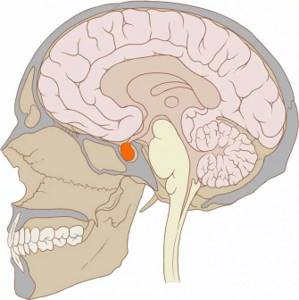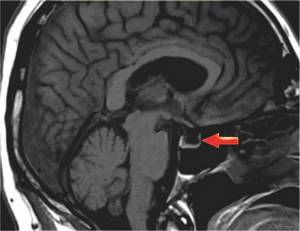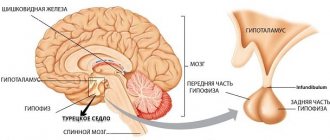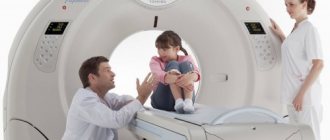26 Nov 2021 at 23:15 MRI of the head in Tushino 41226
The term "empty sella turcica" was coined by pathologist W. Bush in 1951, due to the external shape of the sphenoid bone, which resembles a riding prop. This disease means a disorder in the area of the brain, and more specifically, where the pituitary gland is located, preventing it from functioning. Recently, the diagnosis has become very common due to the growing popularity of magnetic resonance imaging. And many people, having heard the diagnosis, are completely bewildered: what is sella turcica and why is it dangerous?
What it is?
The sella turcica is a hollow formation inside the human skull.
Inside the formation is the pituitary gland, a gland that performs neuro-endocrine regulation of the performance of the entire body by producing hormones. The saddle has a round shape measuring 8-12 mm. However, the production of hormones is controlled by another vital formation - the hypothalamus. The pituitary gland and hypothalamus are connected through a stalk that descends into the saddle. The pituitary gland is protected by the so-called diaphragm of the sella turcica - a plate that separates the cavity from the subarachnoid space. This space is the area around the brain filled with cerebrospinal fluid (CSF). The purpose of the sella turcica is to protect the pituitary gland from mechanical stress. During normal functioning, the pituitary gland fills the entire space of the saddle. And if any malfunctions occur, then the membrane of the brain, descending, begins to put pressure on the contents of the cavity. For example, if for some reason the diaphragm is underdeveloped or thinned, or has a too wide diameter of the opening for the leg, then the cerebrospinal fluid and pia mater easily enter the cavity of the sella turcica and exert pressure directly on the pituitary gland. As a result, it seems to be spread out along the bottom of the saddle, thus forming an empty sella turcica.
Sometimes in medical practice it occurs that the diaphragm of the sella turcica is underdeveloped, but there is no sella turcica syndrome. Therefore, scientists came to the conclusion that intracranial hypertension is necessary for the syndrome to occur. In this case, the cerebrospinal fluid fills not only the entire space of the saddle, putting pressure on the pituitary gland, but also on its stalk. All this causes disruptions in the regulation of the hypothalamus and causes problems with the endocrine system.
Types of pathology
According to statistics, empty sella syndrome is diagnosed in every tenth person. Most often, this disease affects women over 35 years of age who are overweight. This is due to the more active functioning of the pituitary gland in some periods of their life (pregnancy, menopause).
Empty sella syndrome is classified into two types:
- Primary syndrome. It begins in conditions of congenital insufficiency of the diaphragm. The anomaly is asymptomatic and is detected by MRI of the pituitary gland while investigating another disease by chance.
- Secondary syndrome. It appears after a direct effect on the pituitary gland: after irradiation, surgery, an infectious disease.
Predisposition to this disease can be either hereditary or for a number of other reasons.
an appointment for an MRI Make an appointment and get a high-quality head examination in our center
Contraindications
MRI of the pituitary gland has the following contraindications:
- age up to 7 years (unless there is a serious need);
- pregnancy (without strict indications);
- the presence of metal implants in the body;
- epilepsy;
- stage of decompensation of diabetes mellitus;
- kidney diseases;
- allergy to contrast agent (for MRI of the pituitary gland with contrast).
The study should be carried out with caution on people who suffer from claustrophobia. Relative contraindications also include too much body weight – more than 130 kg. The study is only possible if the patient loses weight.
Causes of an empty sella turcica

Doctors highlight several main reasons that significantly increase the risk of sella turcica syndrome:
- Genetic predisposition.
- Disease processes occur in the body. Among them are:
- Hormonal imbalances: menopause, pregnancy, abortion, puberty, taking hormonal contraceptives, surgery to remove the ovaries.
- Cardiovascular problems: heart failure, hypertension, brain tumor, circulatory disorders, cerebral hemorrhage.
- Inflammatory processes in the body.
- Long-term treatment of viral or infectious diseases with antibiotics.
- Overweight.
- External factors. These include: concussion, completed courses of chemotherapy, surgical operations in the pituitary gland.
Symptoms of an empty sella turcica
Empty sella syndrome is manifested by disruptions in the endocrine and nervous systems, and disturbances in the functioning of the visual organs.
During stressful situations, neurological symptoms appear everywhere:
- Increasing headache is the most common symptom of the syndrome. The pain has no specific localization, does not depend on body position, and occurs at different times of the day;
- a jump in blood pressure along with shortness of breath and chills. May be accompanied by pain in the heart, diarrhea, fainting;
- panic fear, acute lack of air, emotional depression or, conversely, anger towards everyone around;
- Abdominal pain and leg cramps may occur;
- sometimes the temperature rises to low-grade levels.
An empty sella turcica of the brain can manifest itself as disturbances in the endocrine system, namely:
- weakened sexual function, enlarged mammary glands in men;
- excess weight - more than 70% with the syndrome suffer from obesity;
- the appearance of diabetes insipidus;
- reduction of the thyroid gland: swelling of the face, drowsiness, constipation, lethargy, swelling of the extremities, dry skin;
- enlarged thyroid gland: sweating, rapid heartbeat, trembling of hands and eyelids, emotional excitability;
- disruptions in the menstrual cycle or even infertility in the fairer sex;
- Itsenko-Cushing syndrome – deterioration of adrenal function. Accompanied by skin pigmentation, mental disorders, and excessive growth of body hair.

The sella turcica is located near the optic nerves. In the presence of the syndrome, they are compressed, thereby disrupting their blood circulation. Therefore, visual symptoms occur in almost absolutely all cases of the disease. Symptoms in this situation:
- deterioration of visual acuity;
- severe tearing;
- splitting of objects;
- the appearance of black dots;
- darkening of the eyes.
In most cases, the above symptoms have many other diseases. The sella turcica can be identified in the brain only after consultation with a specialist and after examination.
Get a free consultation Consultation on the service does not oblige you to anything
Diagnosis of the syndrome
The diagnosis procedure takes place in three stages:
- The doctor's consultation.
Based on the patient's complaints and medical history, the doctor may suspect empty sella syndrome. However, only a comprehensive examination can confirm suspicions. - Laboratory diagnostics.
A blood test is checked to determine hormonal levels. - Instrumental diagnostics.
Several visualization methods can be distinguished. MRI of the brain is considered the most effective for detecting the syndrome. The photographs will show that the pituitary gland is deformed, has an irregular shape, and is shifted in relation to the saddle. You can also use CT (computed tomography), it will accurately indicate the size of the pituitary gland or possible deviations from the norm. One of the more accessible methods is radiography of the saddle area. Although the photographs will show a reduced size of the pituitary gland, however, this method does not allow us to absolutely reliably state the presence of sella turcica syndrome.
Very often, an empty sella turcica is discovered completely by accident, in order to identify sinusitis or forms of traumatic brain injury.
Which doctor should I go to?
If you experience prolonged headaches, excess weight gain, or hypertension, you should consult a neurologist.
If you notice worsening vision, you need to consult an ophthalmologist to rule out or confirm damage to the optic nerves.
A consultation with an endocrinologist is required, as well as a further study of hormonal levels.
Get a free consultation Consultation on the service does not oblige you to anything
Preparing for an MRI with contrast
- Before MRI with contrast, the presence of allergic reactions to contrast agents and diseases for which the study is contraindicated is determined. The patient is scheduled to consult a doctor who, if necessary, will prescribe an allergy test for gadolinium and blood biochemistry.
- The study is carried out on an empty stomach so that the administration of contrast does not provoke nausea and vomiting.
- Before examining the abdominal organs, a cleansing enema is performed. For such patients, it is advisable to exclude foods that provoke gas formation from the menu 2-3 days before diagnosis.
- Some types of MRI diagnostics with contrast are performed with a full bladder.
You can find out more precisely about preparation for a particular study from the clinic’s specialists by calling the numbers listed on the website.
Treatment

As such, there is no treatment for empty sella syndrome. Drug therapy is aimed at eliminating the symptoms of the syndrome. Therefore, if the pathology is discovered completely by chance and does not bother the patient in any way, then it does not require treatment. He registers with a specialist, undergoes periodic examinations, and, if possible, should lead a healthy lifestyle.
For those who are worried about pain and poor health, treatment is prescribed that reduces the symptomatic consequences:
- blood pressure surges;
- migraine;
- decreased immunity, etc.
Surgical treatment is rarely required. And then you can’t do without a neurosurgeon. Indications for surgical intervention:
- the need to remove the tumor;
- leakage of cerebrospinal fluid;
- sagging of the optic nerves (can cause complete loss of vision).
Treatment with folk remedies is extremely ineffective. Often it is simply necessary to eliminate some risk factors: obesity, taking hormonal contraceptives. The best prevention of the disease is a healthy lifestyle.
Forecast
It is impossible to predict the course of the disease. It all depends on the course of SPTS, concomitant diseases and the condition of the gland itself. Constant monitoring of hormone levels in order to eliminate complications in time. Engage in health promotion to help the body fight disease.
Empty sella syndrome is a pathology with an unpredictable course. It may not manifest itself in any way throughout your life, or it can cause many serious endocrine disorders. The choice of therapy can also be completely different: either the principle of non-intervention with routine observation, or surgical intervention with unforeseen consequences.
How is an MRI of the pituitary gland performed?
The study does not require special preparation. Only if a procedure with contrast is performed (prescribed in more complex cases), the patient must refuse food 5 hours before the procedure. You will learn about all the nuances from a specialist at the Meditsina JSC clinic, as well as about the tomography technology.
Main stages of the study
- The patient removes all metal objects.
- It is conveniently located on the tomograph table; its head is fixed with a special holder so that it is motionless. To prevent noise from causing discomfort, the specialist suggests wearing headphones.
- The table is moved into the center of the tomograph, the examination itself takes place, which on average lasts 15-60 minutes.









